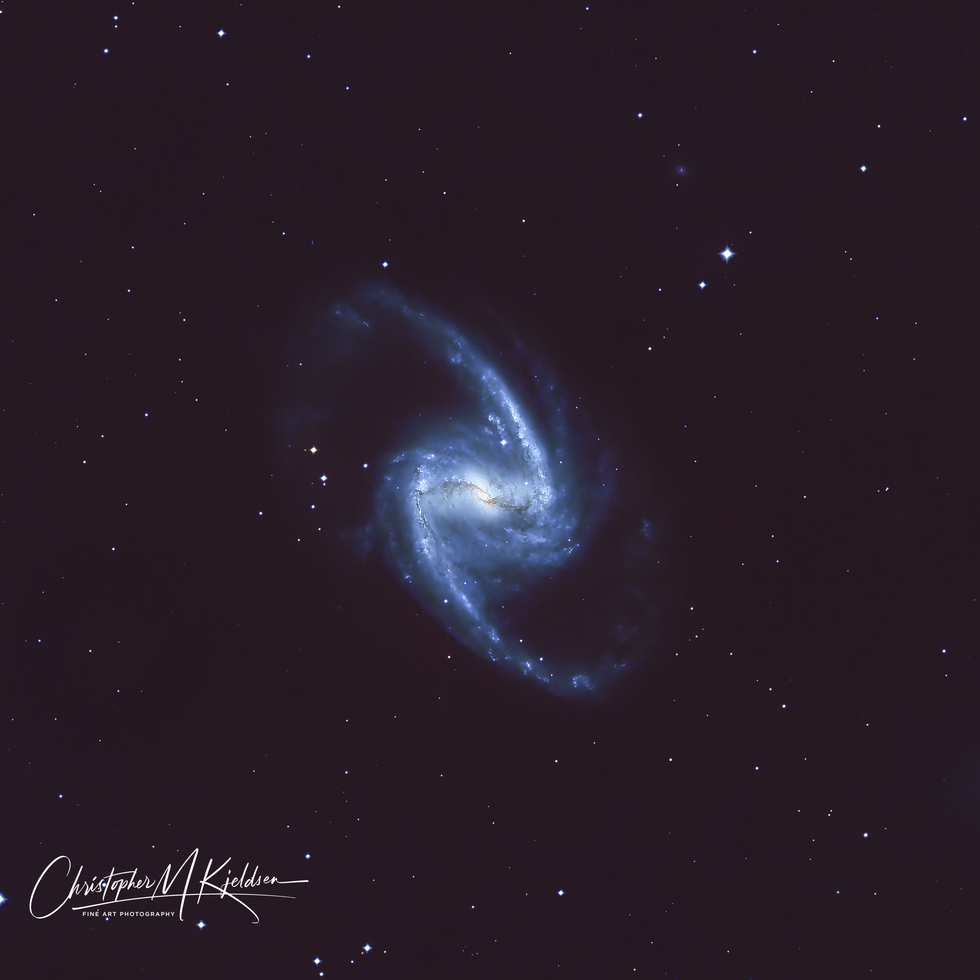NGC 1365 – Great Barred Spiral Galaxy
NGC 1365 – Great Barred Spiral Galaxy
NGC 1365, also known as the Great Barred Spiral Galaxy, is a double-barred spiral galaxy about 56 million light-years away in the constellation Fornax.
Within the larger long bar stretching across the center of the galaxy appears to be a smaller bar that comprises the core, with an apparent size of about 50″ × 40″. This second bar is more prominent in infrared images of the central region of the galaxy, and likely arises from a combination of dynamical instabilities of stellar orbits in the region, along with gravity, density waves, and the overall rotation of the disc. The inner bar structure likely rotates more rapidly than the larger long bar, creating the diagonal shape seen in images.
The spiral arms extend in a wide curve north and south from the ends of the east-west bar and form an almost ring like Z-shaped halo. Astronomers think NGC 1365's prominent bar plays a crucial role in the galaxy's evolution, drawing gas and dust into a star-forming maelstrom and ultimately feeding material into the central black hole.
NGC 1365, including its two outer spiral arms, spreads over around 200,000 light-years. Different parts of the galaxy take different times to make a full rotation around the core of the galaxy, with the outer parts of the bar completing one circuit in about 350 million years. NGC 1365 and other galaxies of its type have come to more prominence in recent years with new observations indicating that the Milky Way could also be a barred spiral galaxy. Such galaxies are quite common — two thirds of spiral galaxies are barred according to recent estimates, and studying others can help astronomers understand our own galactic home.
Four supernovae have been observed in NGC 1365.
The central supermassive black hole in the active nucleus, which has a mass of about 2 million solar masses, rotates at close to the speed of light. These observations, announced in February 2013, were made using the X-ray telescope satellite NuSTAR.
[Wiki]
Within the larger long bar stretching across the center of the galaxy appears to be a smaller bar that comprises the core, with an apparent size of about 50″ × 40″. This second bar is more prominent in infrared images of the central region of the galaxy, and likely arises from a combination of dynamical instabilities of stellar orbits in the region, along with gravity, density waves, and the overall rotation of the disc. The inner bar structure likely rotates more rapidly than the larger long bar, creating the diagonal shape seen in images.
The spiral arms extend in a wide curve north and south from the ends of the east-west bar and form an almost ring like Z-shaped halo. Astronomers think NGC 1365's prominent bar plays a crucial role in the galaxy's evolution, drawing gas and dust into a star-forming maelstrom and ultimately feeding material into the central black hole.
NGC 1365, including its two outer spiral arms, spreads over around 200,000 light-years. Different parts of the galaxy take different times to make a full rotation around the core of the galaxy, with the outer parts of the bar completing one circuit in about 350 million years. NGC 1365 and other galaxies of its type have come to more prominence in recent years with new observations indicating that the Milky Way could also be a barred spiral galaxy. Such galaxies are quite common — two thirds of spiral galaxies are barred according to recent estimates, and studying others can help astronomers understand our own galactic home.
Four supernovae have been observed in NGC 1365.
The central supermassive black hole in the active nucleus, which has a mass of about 2 million solar masses, rotates at close to the speed of light. These observations, announced in February 2013, were made using the X-ray telescope satellite NuSTAR.
[Wiki]
SPECIFICATIONS
Telescope
Planewave CDK24
Camera
FLI ProLine PL9000
Location
El Sauce Observatory, Chile
Date of observation
5/23/2023
Filters
Astrodon Luminance, Red, Green, Blue
Processing
• PixInsight • Lightroom • Photoshop



